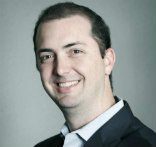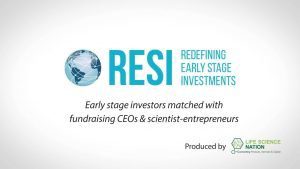
2020 Bio Innovation Conference Highlights the Assets and Aspirations of the BioHealth Capital Region
The 2020 Bio Innovation Conference, which was presented by Maryland Life Sciences, a division of the Maryland Tech Council, was held virtually on October 5-6, 2020.
Over 400 virtual attendees from across the BioHealth Capital Region (BHCR), including leaders from industry, academia, and the venture capital world, participated in two full days of activities that included keynotes, engaging panel sessions, and remote networking opportunities.
The Bio-Innovation Conference kicked off with opening remarks from Martin Rosendale, CEO of the Maryland Tech Council, and Jeff Galvin, the CEO of American Gene Technologies (AGT), which was the conference’s Diamond Sponsor.
“During these unprecedented times, our region…has risen to the challenge demonstrating and showing the world that we are truly number one. The fact that we have more than 70 individuals from international life science companies joining us today further reinforces that we are making our presence known inside and outside the boundaries of the United States,” stated Rosendale in his opening remarks.
“You would just be amazed to understand the tremendous amount of R&D and innovation that is going on in Maryland…I have been developing American Gene Technology in this environment because we have an amazing base of stem education, great universities and over 70 national, federal institutions that are doing advanced research and development in this area. There is a tremendous amount of cutting edge development…everything that you need to put together a team to do something really great with cell and gene therapy is here,” stated Galvin.
Rachel King, the Co-Founder, and CEO, GlycoMimetics, Inc., introduced Jim Greenwood, the keynote speaker, Lifetime Achievement Award recipient, and former CEO of the Biotechnology Innovation Organization (BIO).
Greenwood spoke at length about myriad topics, including the COVID-19 vaccine, the current political climate, Operation Warp Speed and the challenges facing the healthcare industry. At the heart of Greenwood’s keynote was the notion that the remarkable power and promise of biotechnology can only be realized in an ecosystem designed to spark innovation.
“We’ve found cures for 500 diseases, which leaves 7,000 diseases for which we haven’t. We can and we will find those cures…There are no laws of nature that can stop us. Only the laws of man can do that,” stated Greenwood.
A unifying theme of the Bio Innovation conference and its panel sessions reflected Greenwood’s call to arms for creating a legal, regulatory and financial environment in which biotech can thrive. The BHCR is a fine example of a region striving to achieve Greenwood’s vision for a truly innovative biotech ecosystem.
It Takes an Ecosystem
Several panel discussions on the Bio Innovation Conference’s agenda were focused on the state of the BHCR ecosystem and what needs to be done to keep it healthy, vibrant and growing.
The “It Takes an Ecosystem” session truly encapsulated Greenwood’s vision and spoke to the underlying theme of the conference as a whole, The panel session was moderated by Rosemarie Truman, Founder, and CEO, The Center for Advancing Innovation, and included Hansilla Alaigh, Director, External Development. Emergent BioSolutions, Angela Graham, President and CEO, Quality Biological, Inc. and John B. Mumm, Ph.D., President and CEO, Deka Biosciences, as panelists.
“I came to Maryland because there was a lot of talent…The whole point is it takes an ecosystem of people like Angela and others reaching out to companies like mine and helping them to bootstrap as they need to and start to expand. That’s what is required to make the science ecosystem develop and grow,” stated Mumm.
Emergent Biosolutions’ Alaigh stated, “You need to know what you have, where you need to partner and what competencies you need to bring in…awareness is extremely important as well as humility…the fact that we are in a wonderful ecosystem with our government and non-government counterparts has enabled Emergent to become that trusted partner.”
“It’s about relationships. We invest in people. As we grow this ecosystem, the BIoHealth Capital Region…we’ve been able to develop relationships and there are organizations that do a great job making sure we all get together so that we can develop these relationships and pick up the phone if we need something…that’s the beauty of this area,” stated Quality Biological’s Graham.
“There is really a passion for discovery and how we can make a difference. We’re all running companies and need to make a living but it is not the driving factor behind what we do. We’re all trying to make a difference,” she added.
“There is something profoundly unique about the broader scientific community here…there is more of a focus and a mainline to the notion that what we do every day is attempting to impact people’s lives in a positive way. It’s not just about making money,” stated Mumm. “It’s a different perception here. There is a respect for the greater good and that’s part of why I was so attracted to this region.”
The panelists cited proximity to the National Institutes of Health (NIH), the U.S. Food and Drug Administration (FDA), and other government research agencies, the lower cost of living compared to other biohealth hubs, and the deep talent pool as attractive BHCR assets.
“There is huge value here. We are in a very unique environment. Our neighbors are policy makers, ground shattering scientists and regulators. You have everyone at your disposal to make your program successful,” shared Alaigh. “People are gravitating to this area.”
“I find that you’re always 2 or 3 people away from your answer here. The people who make up this ecosystem, well, it may be cliche, but people here are just nice,” stated Graham with a smile.
All of the panelists noted that venture capital investment remains a challenge for the BHCR, but this can be overcome by tapping into the region’s support system, understanding your market and being well-prepared before a startup or emerging company seeking funding.
“I don’t think venture capital is about location. I am a firm believer that there is money out there… and if you are having difficulty raising money you need to be open to the feedback you get and you should reach out to people for help. The Maryland Tech Council’s venture mentor program is a great opportunity to have a lot of CEO and other entrepreneurs help you practice your pitch. Sometimes it’s not just your science it is how you convey the information,” Graham stated.
“If you’re open to the feedback, the capital will come,” she emphasized.
With a rapidly growing advanced biomanufacturing footprint, a blossoming cell and gene therapy and regenerative medicine hub, an established yet rapidly evolving biotech and vaccine development and manufacturing presence, and a deep and varied life science talent pool, the BHCR provides startups, emerging and established companies a vast network they can leverage augment their organizations and start new and exciting ventures and products.
The BHCR encapsulates and illustrates the best of Greenwood’s vision for an healthy, vibrant open, and innovative biotechnology environment.
As the panel’s moderator, Rosemarie Truman, aptly stated, the question at hand should not be “Why the BHCR?, but rather “Why not here?”
- About the Author
- Latest Posts
Over the past 11 years, Chris has grown BioBuzz into a respected brand that is recognized for its community building, networking events and news stories about the local biotech industry. In addition, he runs a Recruiting and Marketing Agency that helps companies attract top talent through a blended model that combines employer branding and marketing services together with a high powered recruiting solution.





